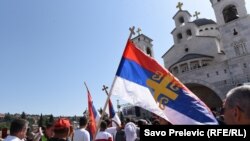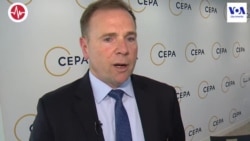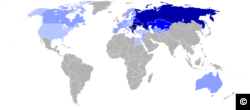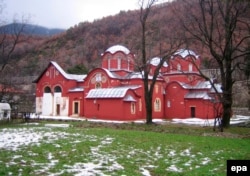On July 20, the Russian government-sponsored web portal Sputnik Serbia accused retired U.S. Lieutenant General Frederick Benjamin "Ben" Hodges of designating Christian Orthodoxy as an enemy of NATO. This followed an interview Hodges gave to the Voice of America Serbian Service, in which he said that the presidents of Serbia and Kosovo should be protected from pressure from both Russia and the Serbian Orthodox Church, as they negotiate to normalize relations between Belgrade and Pristina.
Hodges served as Commander, United States Army Europe (USAREUR) from 2014 to 2017. He is currently the Pershing Chair in Strategic Studies at the Center for European Policy Analysis, (CEPA).
In his VOA interview, Hodges discussed the talks between Serbian President Aleksandr Vučić and the Kosovo President Hashim Thaçi, to ease their strained relations. An agreement between the two countries would open the doors for Serbia to the European Union and allow Kosovo to join international institutions such as the United Nations and Interpol.
“Serbia can be a responsible and positive influence in the region,” Hodges said. “Therefore, I think we need to help provide an opportunity for the two presidents (Vučić and Thaçi), to be able to give them some space. That means no ‘red lines’ imposed from the outside. Help protect them from pressures from Russia, as well as allow them to deal with internal pressures they have, from the Orthodox Church for example.”
A portion of the VOA Serbian Service interview with Ben Hodges, Pershing Chair of Strategic Studies, CEPA. Video produced for by Nik Yarst.
Sputnik Serbia wrote in response: “The fact that the [SPC] Serbian Orthodox Church has been a thorn in NATO’s eye has been known before, but it seems that this is a rare occasions when one of the highest positioned U.S. soldiers bluntly named the Orthodox Church as a key obstacle to transforming the map of the region into an Atlantic model.”
The Moscow-controlled web portal further claimed that the “persecution of the SPC [Serbian Orthodox Church] in North Macedonia, as well as the latest heightened tensions and pressure on its diocese in Montenegro, can be interpreted as part of the wider strategy of the West to counter Orthodoxy.”
Both of Sputnik Serbia’s claims are false.
First, it is important to note that several NATO member states – Greece, Romania, Bulgaria and Montenegro -- have predominantly Christian Orthodox populations. North Macedonia will soon be joining the alliance, and Ukraine and Georgia, which have Orthodox Christian populations, have also applied for NATO membership.
Secondly, the Macedonian and Montenegrin Orthodox Churches have for decades – since even before the breakup of Yugoslavia -- sought autocephalous status and independence from the Serbian Orthodox Church.
NATO’s Orthodox Members
Greece has been a NATO member since 1952 and its population includes more than 10 million Eastern Orthodox Christians.
Eastern Orthodoxy is often called Greek Orthodoxy marking the historic connection between contemporary Greece and the Byzantine Empire, the cradle of Christian Orthodoxy, from which first Bulgaria and then Kyivan Rus’ accepted Christianity in 9th and 10th century, respectively.
Romania, one of the most dedicated NATO members, and a staunch opponent of Russian neo-imperialism, has the fourth-largest population of Orthodox Christians in the world -- 19 million.
North Macedonia, whose population is 70 percent Eastern Orthodox, is poised to join NATO soon. Georgia is next in line with very close relations with the Alliance. While most Orthodox Christians in Russia (estimated between 58 million and 101 million) reportedly do not practice their faith regularly, the Orthodox Church in Georgia has a very strong following and significant public influence.
Ukraine has made the strategic decision to join the Alliance following the Maidan revolution in 2014. With its 35 million Orthodox Christians, Ukraine has the third-largest Christian Orthodox population in the world, almost equal to Ethiopia’s 36 million.
The Autocephalous Eastern Orthodox Model
Unlike the Catholic Church, the Eastern Orthodox Church is structured differently, as each national Church can be independent, or autocephalous (having canonical independence), and therefore not subordinated to a central authority such as the Vatican. For example, the Bulgarian, Romanian, Serbian, Greek, Georgian and other Orthodox Churches are autocephalous: each has its own Patriarchate.
The Bulgarian Orthodox Church, the oldest Slavic Orthodox Church in the world, has been autocephalous since 919. It became the first new patriarchate to join the initial Pentarchy. Its independence preceded the autocephaly of the Serbian Orthodox Church (1219) by 300 years and that of the Russian Orthodox Church (1596) by some 600 years.
In fact, when Kyivan Rus officially adopted Christianity, it procured from Bulgaria church literature and other documents written or translated in the Slavic language under the patronage of Boris I, the ruler of the First Bulgarian Empire. The books introduced the Slavic alphabet, created by the Slavic brothers Cyril and Methodius and their disciples, to Kyivan Rus and, much later, to Russia (which did not exist as a state at that time). The Kyivan Patriarchate was moved to Moscow more than three centuries later, as the Muscovite empire expanded.
Although established more than three centuries before the Russian Orthodox Church, the Ukrainian Orthodox Church – the successor of the Orthodox Church of Kyivan Rus – was the most recent one to gain autocephaly in January 2019. The long struggle for independence from Moscow finally ended when the Ecumenical Patriarch of Constantinople, Bartholomew I, signed a decree of independence in Istanbul, formalizing the Ukrainian Orthodox Church’s split from the Russian Orthodox Church.
The Struggle for Independence and National Sovereignty
The Orthodox Churches of Montenegro and North Macedonia are going through a similar battle for independence from Serbia. And, as in Ukraine, the issue also is tied to national identity, state sovereignty and the history of external domination over the national Church.
The Holy Synod of the Serbian Orthodox Church granted autonomy to the Macedonian Orthodox Church in 1959 in the then-Socialist Republic of Macedonia. However, the Macedonian Orthodox Church remained in canonical unity with the Serbian Church under the Serbian Patriarch. But in 1967, the Macedonian Holy Synod unilaterally announced its autocephaly and independence from the Serbian Orthodox Church. The Serbian Holy Synod, however, denounced the decision and condemned the clergy as schismatic.
The Serbian Orthodox Church has been engaged in a prolonged dispute with the Macedonian Church since independence over recognizing its autocephalous status and jurisdiction over Church properties in North Macedonia.
The Ecumenical Patriarchate of Constantinople does not recognize the Macedonian Church as independent, though the Bulgarian Orthodox Church has been supportive of its aspirations for autocephalous status. In 2017, the Bulgarian patriarch received a formal request for help from his counterpart in Skopje. However, any unilateral move in that direction could turn the matter “into an apple of discord among Orthodox Churches...and damage the fragile peace in the Western Balkans,” warned Ines Murzaku, Professor of Church History at Seton Hall University in New Jersey.
The Montenegrin Orthodox Church proclaimed itself autocephalous in 1993, but, like its Macedonian sister Church, it has not won international recognition. The Montenegrin Orthodox Church was autocephalous until 1918, when Belgrade banned its activities after the creation of the Kingdom of Serbs, Croats, and Slovenes, renamed the Kingdom of Yugoslavia in 1929. In 1922, Serbia obtained from Constantinople a decree recognizing the “unification” of the Serbian Orthodox Church with the Montenegrin Church.
But the question of the Montenegrin Orthodox Church’s independence from Serbia has become a national concern, which Montenegro’s President Milo Djukanovic clearly expressed last December. “The Serbian Orthodox Church has very persistently been undermining Montenegrin independence. I believe that it is necessary to continue the work on restoring the autocephalous Montenegrin Orthodox Church, and the state will do this and bear responsibility for this,” said Djukanovic.
In June, he said that “the Serbian Orthodox Church is trying to obstruct, through various forms, the European desires and ambitions of contemporary Montenegro, seeking to preserve its religious monopoly in Montenegro, and obstruct the establishment of the rule of law.”
Analysts in Belgrade also confirmed the Serbian Orthodox Church’s efforts to weaken Montenegro’s independence and even attempt to reverse its NATO membership (Author’s interviews in Belgrade in June 2019).
The struggle of Montenegro and North Macedonia for an independent Church resembles the fight of Ukraine to split its Church from that of Russia. Ukraine had been under Russian military attack for five years and still had to justify to the world why Moscow should not dominate its Orthodox Church.
Both Moscow and Belgrade have reportedly attempted to undermine the sovereignty of neighboring states through the influence and control of their Orthodox Churches. While NATO does not view Orthodoxy as an adversary, the Russian Orthodox Church and the Serbian Orthodox Church evidently view NATO and its allies as enemies.
Still, the interests of Moscow and Belgrade don’t always coincide with those of their respective Orthodox Churches: while Belgrade, supported by Moscow, would like Kosovo partitioned and its northern part added to Serbia, the Serbian Orthodox Church in Kosovo is against this, as it would lose half of its parishioners and, consequently, its standing in Kosovo. Ben Hodges stressed this in his interview.












